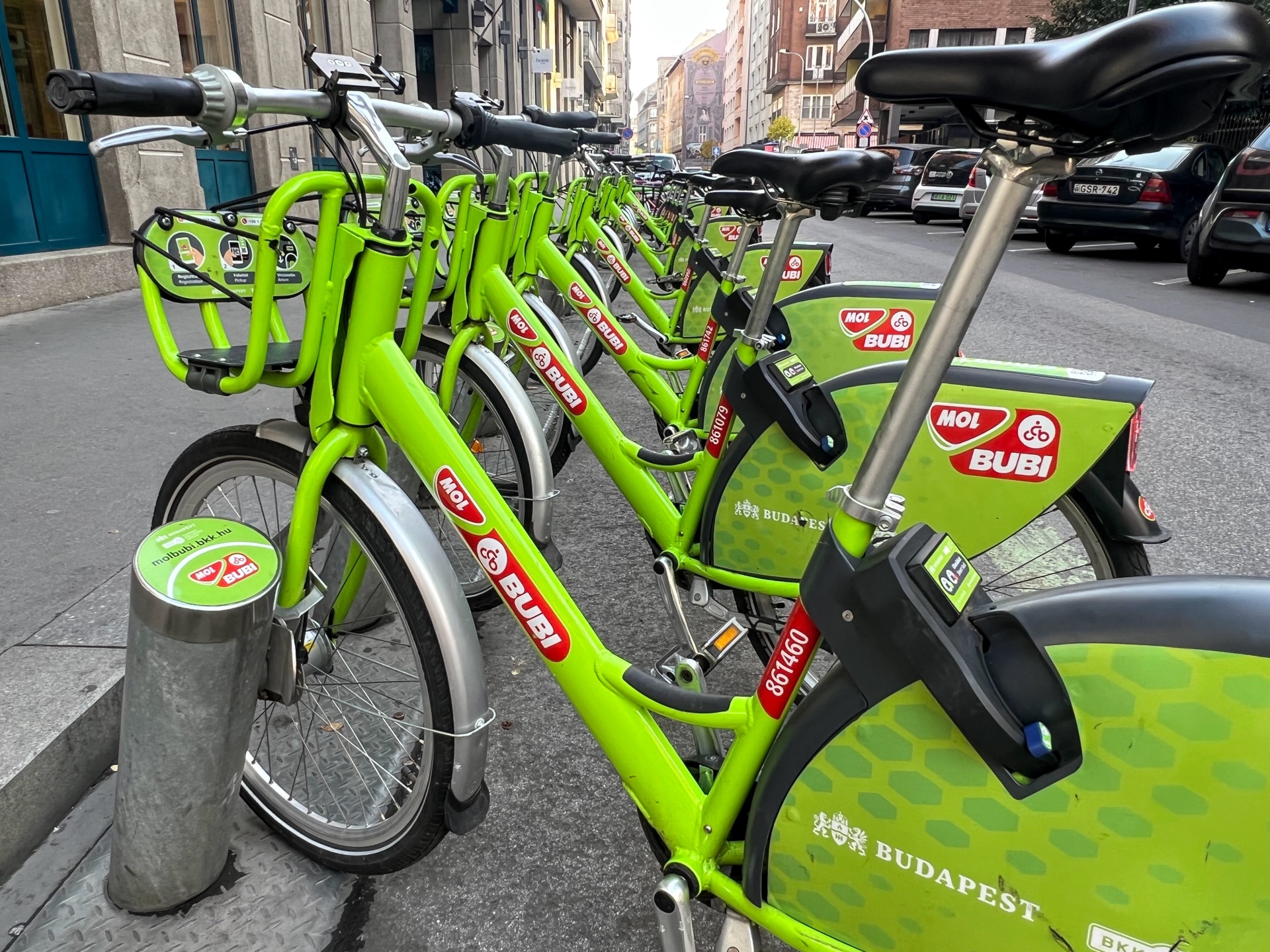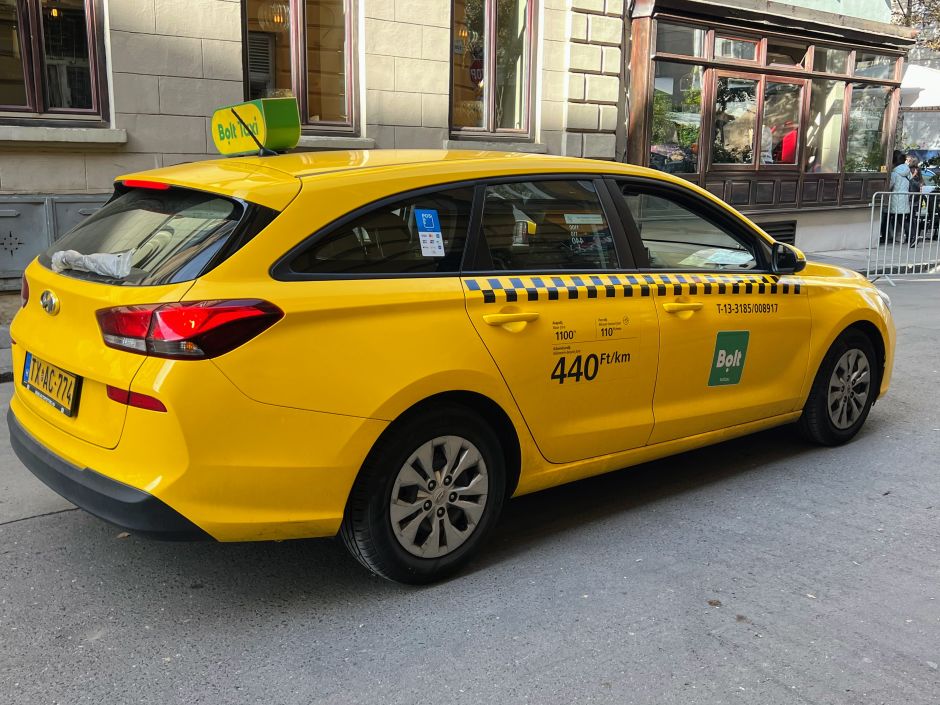Walking, biking, and public transportation are the best ways to discover Budapest. See some specific recommendations below.

Getting to and from the airport
Budapest's airport shuttle bus – 100E Airport Express – connects the city center (Deák Ferenc tér) with the Ferenc Liszt International Airport. The trip takes about half an hour, and with a €5.5 (HUF2,200) one-way ticket, it's a cheap and quick way to get into and out of the airport. I suggest you purchase a ticket ahead of your trip through the user-friendly BudapestGO app (App Store; Google Play), else you'll have to wait out the line at the vending machine by the stations. The shuttle buses run every 7-8 minutes throughout the day (also at night, but somehwat less frequently; the app provides detailed schedules).
As for taxis, note that there's no flat-rate service to and from the airport. To take a licensed cab, you'll need to go to the taxi booth at the airport located just outside the arrivals, provide your destination, then give the printout to the cab driver. Depending on your final destination, the ride will cost the Hungarian forint equivalent of approximately €30 to €40.
Exploring Budapest on foot
Walking is the best way to discover a new city, and most attractions, restaurants, bars, and thermal baths in Budapest are easily within walking distance of the city center. Széchenyi Thermal Baths is one of the more far-flung destinations, but even that's only a 40-minute walk from downtown, and reaching it via the beautiful Andrássy Avenue is an experience in itself.
Are you crossing over to the Buda side? The bridges are shorter than they seem – the recently renovated and pedestrianized Chain Bridge is only 375 meters (1,230 feet) long – and hiking trails lead up to both the Castle Hill and the Gellért Hill. My district-level overviews can help you get to know the main pockets of Budapest.
Biking: MOL Bubi
An alternative to walking is using MOL Bubi, Budapest's bicycle sharing system. With more than 200 docking stations and 1,800 bicycles, the network provides an excellent coverage of the inner parts of Pest, primarily within the Grand Boulevard. Although there exist docking stations on the other side of the Danube too, Buda's rolling hills are less biker-friendly than the flat terrain of Pest.
You can rent a bike through the MOL Bubi app (App Store; Google Play). Unless you have a Hungarian residency card, you'll need to use the "Pay-as-you-go" option which charges by the minute, but it's cheap; a half-hour bike ride, for example, costs HUF 1,200, the equivalent of €3.
Public transport
Budapest has an especially good public transportation system – buses, trolleys, and trams roam the city (subways do too, but then you wouldn’t see as much of it). Good news if you're older than 65 and from an EU country: all public transport in Budapest is free for you. For everyone else, the cost of a single fare is HUF 450 (~€1.25). One-day, three-day, and weekly tickets are also available, which you can purchase on the same BudapestGO app (App Store; Google Play) used for the the airport shuttle bus.
Once you bought your ticket, remember to validate them by scanning the barcode located on the bus and tram doors and the driver's booths. If you don't want to deal with the app, there are ticket vending machines at most stations. You can also buy tickets directly from the bus drivers, but those will be slightly more expensive and you'll hold up traffic. For directions and schedules, rely on a most loyal friend: Google Maps.
Several public transportation lines provide a memorable sightseeing tour for merely the cost of a fare. On tram #2, you'll have plenty of opportunities to marvel at the Hungarian Parliament building and the Buda Castle, both UNESCO World Heritage sites, as the tram rumbles along the Danube's bank. For the best experience, go from Jászai Mari tér to Fővám tér, and if you're curious about Budapest's National Theater and the Müpa cultural center (home of the Ludwig Museum of Contemporary Art), take it all the way to Közvágóhíd.
The Millennium Underground dates back to 1896, making it the first subway line on the European continent (today also a UNESCO World Heritage Site). It runs beneath Andrássy Avenue, passing the Opera house, the House of Terror museum, and Széchenyi Thermal Baths. Hop on at any of the stations for a few stops to experience this charming piece of living history. More recently, the M4 subway line, completed in 2014, has won prestigious design awards, especially the Fővám tér and the Szent Gellért tér stations.
Bus #16, also known as the Castle Bus, will take you from the city center of Pest (Deák Ferenc tér) to the Castle Hill and the Royal Palace. Get off the bus at Dísz tér, and you're smack in the middle of the old town.
The two busiest tram lines in Budapest, #4 and #6, offer panoramic vistas while they cross the Danube. They travel through the Grand Boulevard, the dividing line between inner and outer Pest. Tens of thousands of people from all walks of life ride these trams daily, so a journey from Széll Kálmán tér to Boráros tér lets you see a true cross-section of Budapest's residents.
A trip on bus #5 can offer a glimpse into the well-off neighborhoods in the Buda foothills. Once at Pasaréti tér, architecture fans might enjoy a walk through the Napraforgó utca model housing estate designed by Bauhaus pupils and their acolytes in the 1930s.
Finally, the charming Danubian city of Szentendre is also within reach by public transport, using the HÉV commuter rail line. In about forty minutes from Batthyány tér, you can soak up plenty of art and Mediterranean-Balkan vibes. Along the way, the train passes giant Communist-era housing blocks and the ancient Roman remains of Aquincum. How to spend a day in Szentendre? Here are some ideas.
Taxis
Cab prices are regulated across all taxi operators in Budapest. The fare consists of a base fee of HUF 1,100 (€3) plus a distance-based charge of HUF 440 per km (€1.25). Licensed cabs are yellow, and you can recognize them by the corporate logos appearing on both sides of the front doors, and the official prices displayed on one of the rear doors.

In theory, you should feel free to hail any yellow cab off the street without being overcharged, but I recommend that you use one of the mainstream providers. Bolt has an easy-to-use app (App Store; Google Play) and works like an Uber or a Lyft, except the drivers are licensed cabbies. Other reputable taxi companies include City Taxi (+36 1 211 1111), Főtaxi (+36 1 222 2222), or Tele 5 (+36 1 555 5555). All cabs are required by law to accept credit cards.
Try to avoid freelance cabs; they're also yellow, but instead of the corporate logo, "freelance" and "független szolgáltató" are written in black on their front doors and their roof signs simply say "taxi" instead of the taxi company's name. If you need to take one, be sure to agree on a price upfront with the driver to avoid unpleasant surprises. A ride within the city shouldn't cost more than €15 (HUF 6,000 or so), while €35 (HUF 14,000) ought to get you to the airport.
Uber & Lyft
Thanks to the local taxi driver lobby, Uber was banned in Hungary in 2016. Lyft and other ridesharing companies don't operate in Budapest either. The Bolt app (App Store; Google Play) provides the most comparable service to those.
Electric scooters
Since 2019, Lime electric scooters have flooded Budapest. As in other major cities, electric scooters aren't properly regulated and safety is an issue, especially for pedestrians on the sidewalk. Note that there are several so called "no parking zones" that include parts of downtown (District 5), Margaret Island, and the Castle District. The app has all the details. If this is your chosen form of transport, please be mindful of others sharing the road.